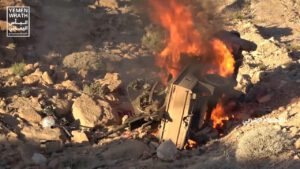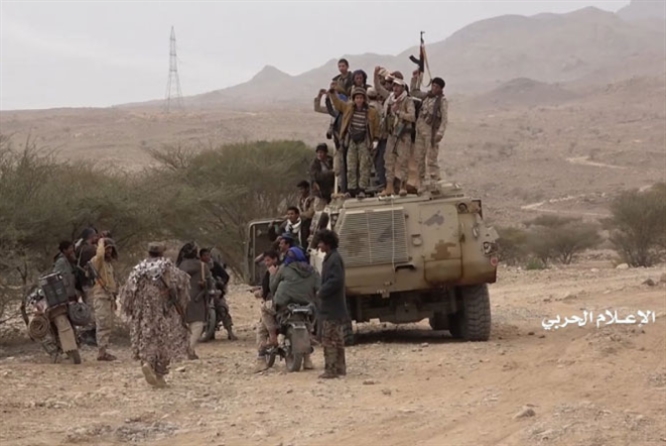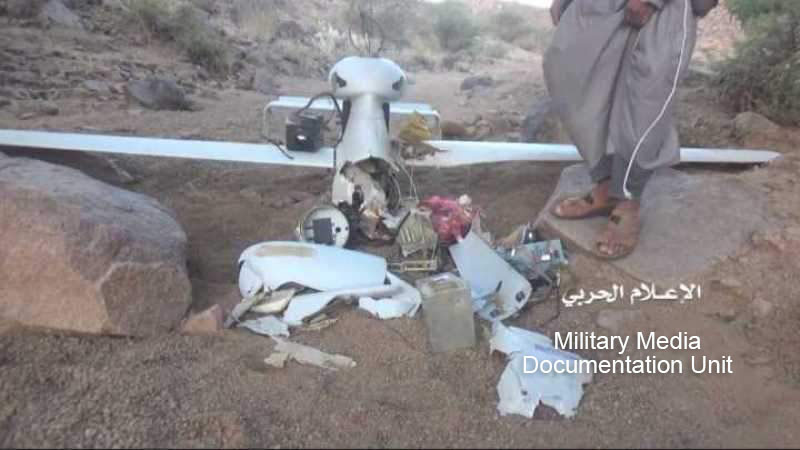www.aljazeerah.info
News, February 2020
Archives
Mission & Name
Conflict Terminology
Editorials
Gaza Holocaust
Gulf War
Isdood
Islam
News
News Photos
Opinion Editorials
US Foreign Policy (Dr. El-Najjar's Articles)
www.aljazeerah.info
|
Editorial Note: The following news reports are summaries from original sources. They may also include corrections of Arabic names and political terminology. Comments are in parentheses. |
1500 Pro-Saudi Fighters Killed, 1830 Injured, Hundreds Detained, Saudi Airports Attacked with Yemeni Missiles, 250 Saudi Air Strikes
February 1, 2020
Editor's Note:
This battle was fought between pro-Saudi and anti-Saudi Yemeni forces for about three days, starting from January 15, 2020.
However, Houthi forces announced the news about it on January 31, 2020.
 |
 |
| A pro-Saudi military
vehicle on fire during the Houthi Attack on Nihm, January 30,
2020 |
Yemeni Houthi fighters
capturing a pro-Saudi military vehicle during their Houthi Attack on Nihm, January 30, 2020 |
 |
 |
| Yemeni Air Defenses Shoot Down Saudi Spy Drone in Jizan, January 28, 2020 |
Saudi-Led Coalition Escalates Airstrikes on Sana’a, Al-Jawf and
Najran, January 27, 2020 |
Editor's Note:
This battle was fought between pro-Saudi and anti-Saudi Yemeni forces for about three days, starting from January 15, 2020. However, Houthi forces announced the news about it on January 31, 2020.
Yemen’s Operation ’Firm Structure’: 1500 Militants Killed, 1830 Injured, Hundreds Detained
Al-Maseerah TV, February 30, 2020
Yemeni Armed Forces Spokesman Brigadier General Yehya Saree held a
press conference to announce details of the Operation ‘Firm Structure’
noting that the operation started with confronting the Saudi-led
aggression’s escalation.
Saree explained that Nihm witnessed
military operations by the aggression forces, which pushed our forces to
deal seriously with this threat.
In light of the success in the
operation, the Yemeni forces went forward in their counter offensive
along the operations field, Saree added.
“The main goal of the
‘Firm Structure’ operation was to deter the enemy forces and expel them
out of the region, eventually securing the area entirely."
Operation ‘Firm Structure’, Saree said, aimed at thwarting the offensive
against our forces and advance towards the areas close to the capital
Sanaa.
According the Yemeni Armed Forces intelligence, the enemy
has been preparing for this operation since months ago, with the aim to
reach the nearest area linked to Sanaa.
The enemy forces in Nihm
were composed of 17 brigades, and a number of battalions that was
supplied with different kinds of weapons, the statement added.
“An entire military zone of the enemy used Nihm as its platform,” Saree
said, adding that Special Forces of the countries of the coalition of
aggression were in charge of fire and intelligence support of the
mercenaries force in Nihm.
Nihm is a mountainous area with
complicated topography, Saree said, a matter that pushed the Yemeni
Armed Forces to deploy Special Forces in the first days of the battle.
After the successful confrontation of the enemy forces’ offensive,
the Yemeni Forces started a military offensive that was based on the
collapse of the enemy’s forefronts, allowing our forces to advance
towards the strategic heights, Saree added.
The Yemeni Forces,
he added, succeeded in the operational duties in the first hours of the
operation, before which the command ordered surrounding the enemy forces
from different eastern and western tracks.
In the first three
days of the operation, Saree explained, the Yemeni armed Forces secured
most of the Nihm area, which include all of strategic sites.
The
offensive was from the all four main sides and all branches which
resulted in different tracks.
The Yemeni forces were keen to
surround the enemy forces inclusively while opening other tracks to
allow the most possible number of mercenaries flee the place.
Saree went on to say that the Yemeni Armed Forces made military pressure
on all enemy’s sites and camps to force them to surrender.
At
the same time, the Yemeni Armed Forces were keen on the Yemenis’ lives
at the enemy’s sites, namely those who showed readiness to flee the
battlefield.
They also succeeded in dealing with the enemy’s
forces in clashes and direct fighting after giving them the chance to
flee.
“With the defeat of the enemy forces, the Yemeni Armed
Forces continued to advance beyond Nihm,” Saree stated.
As the
Yemeni Forces were keen to save lives of the mercenaries, thousands of
them were able to flee the battlefield in the first days.
The
enemy’s warplanes, meanwhile, waged more than 250 strikes
against the Yemeni Forces.
Elaborating on the Aerial
Defense Units’ role in the Operation ‘Firm Structure’, Saree said the
Fatir-1 missile system played a crucial role in confusing the warplanes
and preventing them from launching airstrikes.
He further noted
than the Aerial Defense system carried out more than 25 operations
forcing the enemy’s aircrafts to leave the area.
“The command’s
instructions were clear to strike Saudi facilities and military bases in
response to the airstrikes.”
He also explained that the Rocketry
Force and the Propelled Ai Force targeted many airports the enemy uses
for military purposes, while the missile and aerial strikes
targeted airports in Najran and Jizan in addition to targeting the
Khamis Mushait base with a number of missiles.
Their
first operations, he noted, only represented a warning, but the
continuity of air bombing led to targeting an economic target of Aramco
Company, in addition to two sensitive targets in the enemy’s depth.
Saree also noted that the aforementioned forces played a crucial role
reflecting the command’s instructions related to the deterrence
strategy.
In further details, he said they carried out more than
41 inside and outside operations between January 25th and 30th. As part
of their role, the Rocketry Force and the Propelled Air Force carried
out 26 operations targeting the airports of Abha, Jizan and Najran. They
also targeted Khamis Mushait base, Aramco Company and sensitive sites in
the Saudi depth.
Saree noted that the Operation ‘Firm Structure’
led to a major defeat in the enemy’s lines, while hundreds of the
mercenaries fled the area.
The major achievement of the Yemeni
Armed Forces was securing Nihm in the first days of the operation. Saree
also stated that the Yemeni forces reached al-Jawf and advanced inside
al-Jawf Province, clashing with the forces that were in the same area.
The Yemeni Armed Forces, meanwhile, started another offensive in
al-Jawf to liberate the provinces of al-Jawf and Ma’rib. Saree told the
press conference that the liberation of those two provinces, in addition
to Nihm, occupied an area of 25002 kilometers.
Relatively, Saree
hailed the patriotic stance of the tribesmen, which mainly contributed
to the liberation of many areas located in the field of the operation.
“The Al-Hazm Directorate, which includes the capital of al-Jawf was
an area of confrontation, as well as some parts of the directorates of
Ghayl and Madghal in Ma’rib,” Saree said.
The Operation ‘Firm
Structure’ boosted our forces in their forefronts close to Ma’rib, Saree
said, adding that more than 3500 members were either killed, injured or
detained. He made clear that the bodies of 1500 killed militants are
still in the operations’ field.
According to Saree, 1830 of them
were injured, in addition to hundreds of others who were detained.
He concluded his conference as saying that due to the big number of
those killed, the command ordered the formation of humanitarian
committees whose role is to document details about all bodies.
***
The following news stories are from the Yemeni independent website Al-Masdar ( http://www.almasdaronline.com/category/42 ):
***
Hadi blames Iran for Marib attacks in meeting with U.S. military chief
Almasdar Online, 30 JANUARY, 2020
Yemen President Abdrabbuh Mansour Hadi blamed Iran on Tuesday for Houthi military escalations east of the capital Sana’a, claiming that the rebels are operating under Iranian directives in response to the U.S. killing of the Qods Force commander Qassem Soleimani.
At a meeting with U.S. Central Command chief, Gen. Kenneth McKenzie, Hadi said that Iran was “seeking to control maritime navigation through the Straits of Hormuz and Bab Al-Mandab" on Yemen’s southwestern coast.
Violent clashes erupted last week between the Houthis and the Yemeni army after the rebels struck a mosque at the Reception military camp in Marib governorate with a ballistic missile, killing more than 110 army soldiers. Since then, the Houthis have made significant gains northeast of Sana’a, seizing strategic Al-Manara mountain in Nihm district, taking control of positions in Marib’s Majzar district and forcing the government forces to retreat to the Al-Jafra area in the same district.
Meanwhile, Yemen’s Foreign Minister Mohammed Al-Hadhrami, in a meeting with Swedish Envoy to Yemen Peter Semneby, said on Tuesday that the Houthi military escalations were taking advantage of the UN-sponsored Stockholm agreement, which prevented further military escalation around the port city of Hodeidah in late 2018, by redirecting military efforts elsewhere including in Marib.
Al-Hadhrami said that, after talks with the Saudi-led coalition leadership, the Yemeni government is now considering its options in light of the Houthi exploitation of the deal.
Al-Hadhrami blamed the rebels for the collapse of the peace process, and accused the Houthis of seizing 127 metric tons of food aid from a warehouse of the World Food Program in Hajjah governorate on Sunday, though an investigation into the incident is ongoing. He expressed shock at the silence of the international community on the Houthi violations.
Yemen army claims downing of Houthi drone in Al-Jawf
Almasdar Online, 30 JANUARY, 2020
Yemeni army forces said Wednesday that they shot down a Houthi drone in Al-Mutoon district, located in the western part of Al-Jawf governorate in northern Yemen.
Government forces were shown posing in a photo with a drone they claim to have shot down in the Al-Jar’oob front of Al-Mutoon, but they said were unable to verify whether it was a surveillance or reconnaissance drone. The pictured aircraft resembles the Houthi “Rased” drone, which is virtually identical to the Chinese-made Skywalker X-8 hobbyist plane.
Al-Mutoon has been the site of intense fighting in recent days between the Houthis and the government forces. Yemen’s army has been trying to retain long-held positions there, including the governorate compound in the same district.
Meanwhile, Houthi spokesman Yahya Suray'a, held a press conference to announce the rebels’ military advances northeast of the capital Sana’a since last week. Suray’a said the rebels took control of Nihm district in Sana’a governorate, as well as districts in Marib and Al-Jawf governorates without specifying which ones.
On Tuesday, on the other side of the country along Yemen’s Red Sea coast, government forces said they recaptured five strategic hills in Al-Dhabab district in southwestern Taiz governorate after a week of heavy fighting against the Houthis.
***
The following news stories are from the pro-Houthi website Yemen Extra (http://www.yemenextra.net/):
***
Yemeni Air Defenses Shoot Down Saudi Spy Drone in Jizan
January 28, 2020, YemenExtra, M.A.
Air Defenses of the Yemeni Army and Popular Committees shot down,
Tuesday, a hostile spy drone run by the Saudi-led coalition across
Jizan.
A military source reported that the coalition’s spy drone
was shot down in Al-Malahit area off Jizan with an undisclosed missile.
On January 14, the Air Defenses also shot down a spy drone run by
the forces of the US-backed coalition in Al-Amoud mountain, Jizan, with
an undisclosed missile.
Saudi-Led Coalition Escalates Airstrikes on Sana’a, Al-Jawf and Najran
January 27, 2020, YemenExtra, M.A.
The aerial Saudi-led
coalition escalated its airstrikes, Sunday, on a number of military
fronts and civilian areas, targeting by about 29 strikes a number of
areas in Sana’a, Al-Jawf and Najran frontlines.
A security source confirmed that the US-backed coalition drones launched a series of over 16 separated airstrikes on Khab W Al Sha’af district in Al-Jawf governorate.
The source indicated that various areas in Nihm district located in Sana’a governorate were also subjected to at least eight airstrikes waged by the Saudi-led coalition aircraft.
On Najran’s front, a military source said that a coalition drone launched five airstrikes on Al-Boqa region.
Sana’a Gov. Hands Over 64 Children Recruited by Saudi Regime
January 27, 2020, YemenExtra, M.A.The National Committee for Prisoners’ Affairs handed over 64 children recruited by the Saudi-led coalition after capturing them on the frontlines to the Ministry of Social Affairs under the auspices of the United Nations Children’s Fund (UNICEF).
With the Ministry of Human Rights, the Ministry of Social Affairs and Labor and the National Committee for Prisoners’ Affairs organized in the capital Sana’a, Monday, an event for handing over and receiving children who had been recruited by the Saudi-led coalition and their mercenaries, under the supervision of UNICEF.
During the event, head of the National Committee for Prisoners ‘Affairs, Abdul Qadir Al-Mortadha confirmed that a large number of these children prisoners’ were recruited to defend the Saudi borders.
Al-Murtada added that ”the captured children that we are handing over to Social Affairs and UNICEF are a living witness about who is the party that recruits children, warning that the recruitment of children by Saudi mercenaries continues.
Al-Murtada explained that the captured children who were turned over to Social Affairs and UNICEF will undergo a two-month rehabilitation program and then will be returned to their families.
In turn, the Minister of Human Rights, Radhia Raouh, affirmed that the countries of the US-backed coalition ignore all international norms and proceed with the recruitment of children, devaluing the Yemeni blood.
***
Share the link of this article with your facebook friendsFair Use Notice
This site contains copyrighted material the
use of which has not always been specifically authorized by the copyright
owner. We are making such material available in our efforts to advance
understanding of environmental, political, human rights, economic,
democracy, scientific, and social justice issues, etc. We believe this
constitutes a 'fair use' of any such copyrighted material as provided for
in section 107 of the US Copyright Law. In accordance with Title 17 U.S.C.
Section 107, the material on this site is
distributed without profit to those
who have expressed a prior interest in receiving the included information
for research and educational purposes. For more information go to: http://www.law.cornell.edu/uscode/17/107.shtml.
If you wish to use copyrighted material from this site for purposes of
your own that go beyond 'fair use', you must obtain permission from the
copyright owner.
|
|
|
|
||
|
||||||


